#15 January 1889
Text



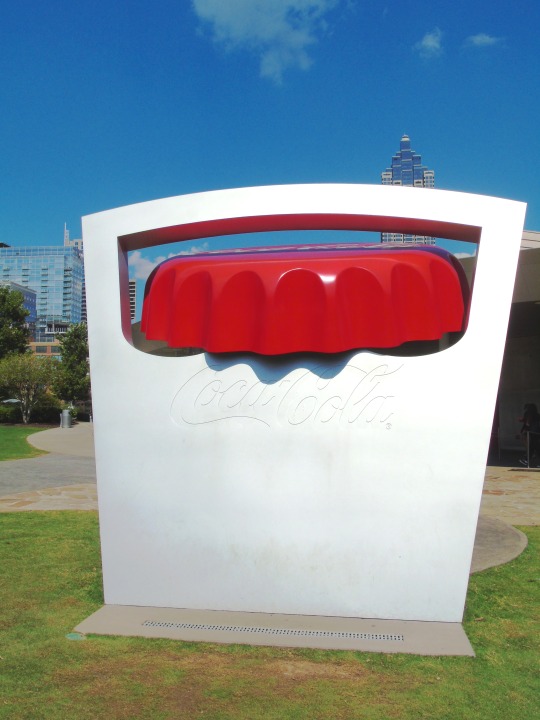


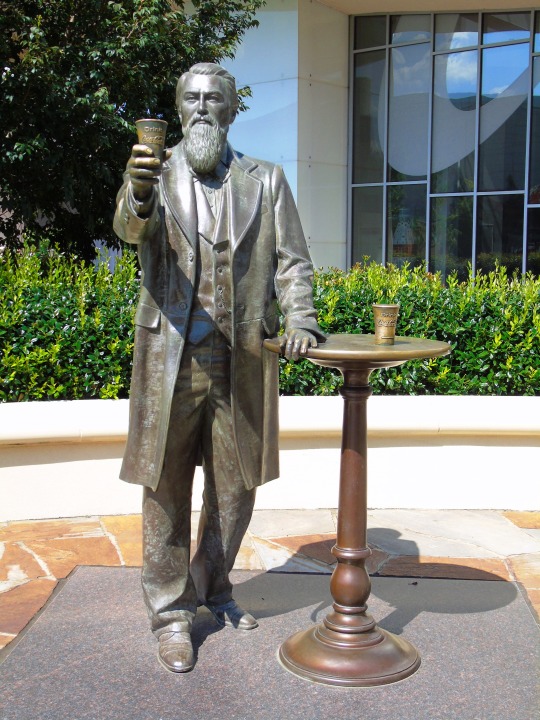










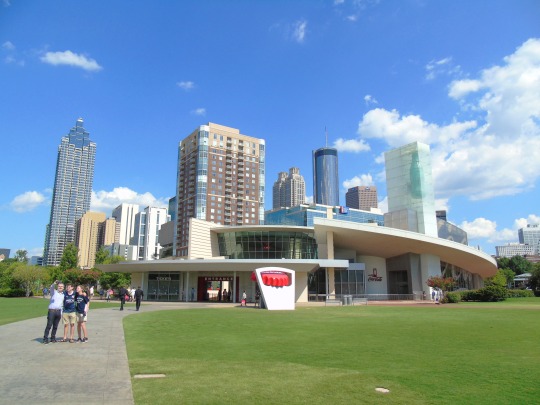


The Coca-Cola Company, then known as the Pemberton Medicine Company, was incorporated in Atlanta on January 15, 1889.
#Coca-Cola Company#Pemberton Medicine Company#incorporated#Atlanta#15 January 1889#135th anniversary#US history#soft drink#Georgia#vacation#Centennial Olympic Park#World of Coca-Cola#original photography#USA#summer 2016#tourist attraction#landmark#architecture#cityscape#Gott's Roadside#St. Helena#California#John Pemberton by Russ Faxon#Paradise#Las Vegas Strip#travel
3 notes
·
View notes
Text
Adolf Hitler
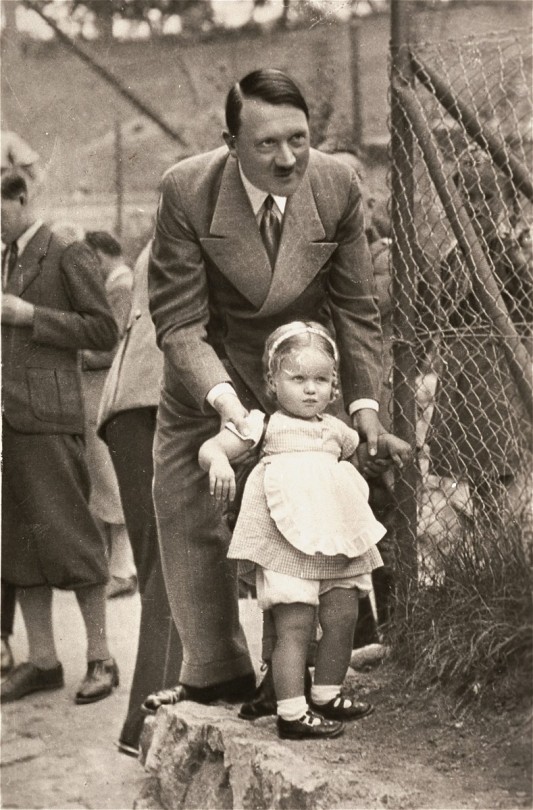
These are some facts and curiosities about Adolf Hitler:
He was born Braunau am Inn on 20 April 1889
On 16 August 1914, when the German Empire had already entered the First World War, Hitler enlisted as a volunteer at the age of 25 in the Bavarian army of Kaiser Wilhelm II, being assigned to the 1st Company of the 16th "List" Infantry Regiment, belonging to the 6th Reserve Division.
On 15 October 1918 he was subsequently temporarily poisoned by a mustard gas attack, which left him blind for three days. He was immediately admitted to Pasewalk Military Hospital where, according to some sources, he learned the news of the German defeat on November 9th.
While still in the army he was tasked with spying, on behalf of the army and the police, on the meetings of a small nationalist party, the German Workers' Party (DAP). During the session held by the political group at the Sterneckerbräu, a beer hall in center of the city, that same evening, Hitler had a violent argument with another customer.
Fascinated by his speech, Anton Drexler, the founder and secretary of the party, signed him up, without even consulting him
Hitler was not discharged from the army until 1920, after which he began to take part full-time in party activities.
He soon became its leader and changed its name to the National Socialist German Workers' Party.
A key element of Hitler's appeal to the German people was his constant appeal to national pride, wounded by defeat in war and humiliated by the Treaty of Versailles, imposed on the German Empire by the victorious states.
Hitler's success was based on conquering the middle class, hit hard by the inflation of the 1920s and the unemployment brought about by the Depression. Peasants and war veterans made up other groups that supported the Nazis.
On January 30, 1933, Hitler was sworn in as Chancellor in the Reichstag chamber, under the gaze and applause of thousands of Nazi supporters.
Using the pretext of the Reichstag fire, Hitler issued the "Reichstag fire decree" on 28 February 1933, less than a month after taking office. The decree suppressed most of the civil rights guaranteed by the 1919 constitution of the Weimar Republic in the name of national security
It is rumored that he had an incestuous relationship with his niece, Geli Raubal.
His photo was put in the Times.
When Hindenburg died on 2 August 1934, Hitler (who as already head of government, Reich Chancellor) could not also become Reich President (head of State), created a new position for himself, that of Führer which allowed him to combine the two tasks.
To demonstrate German power to the world, Hitler (on Goebbels' idea) hosted the 11th Olympiad in Berlin, with a triumphal opening ceremony. On 25 October of the same year, a treaty of friendship between the Kingdom of Italy and Germany was signed in Berlin.
Hitler personally directed the war operations, exercising a decisive influence in strategic choices and operational management.
Responsible for the death of millions of people, Hitler was the proponent of a nationalist and racist ideology, as well as a policy of discrimination and extermination that affected various ethnic, political and social groups: Slavic populations, Romani ethnic groups, Jehovah's Witnesses, homosexuals, opponents politicians, prisoners of war, the physically and mentally disabled and, especially, the Jews.
Having remained stranded with the troops loyal to him in a Berlin now surrounded by the Red Army, he committed suicide in his bunker on 30 April 1945 together with his partner Eva Braun, whom he had married the day before.
He was nominated for the Nobel Peace Prize in 1939.
Sources:
Wikipedia: Adolf Hitler
Military Wiki: Adolf Hitler
I DON'T SUPPORT NAZISM,FASCISM OR ZIONISM IN ANY WAY, THIS IS JUST AN EDUCATIONAL POST
64 notes
·
View notes
Text
Chasseur Trinity Timeline
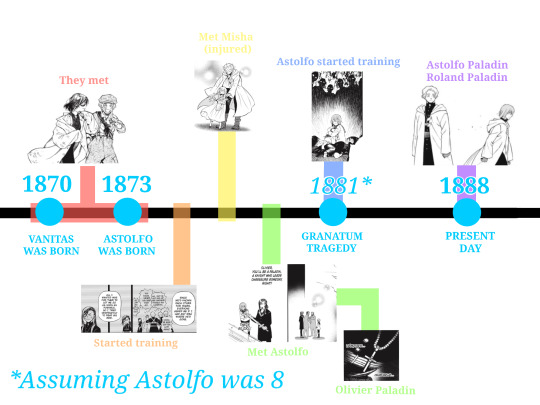
Hello there, I'm back with my timelines because I need everything to be in order XD
Since this time I didn't wrote a lot of things in the timeline, I will explain my points below (anyways, if after reading it you have some question, don't doubt and tell me):
First of all, we know that in present day Olivier is 27 y.o and Roland is 26 y.o thanks an old Omake (I don't have it rn, sorry).
1) Roland and Olivier met:
I don't know if they are around 8, 10, 12 or more so I used a big period of time in which they could have started meeting.
2) Roland and Olivier arrived Paris:

This is when they started they training as Chasseurs and we got some information:
Olivier hairstyle was different.
They were late teens or young adults here.
Roland was covered in bandages (for training or a mision).
Side note: importance of Roland's scars.
Roland's scars were what I used to organise the events between they met and when Astolfo lost his family:
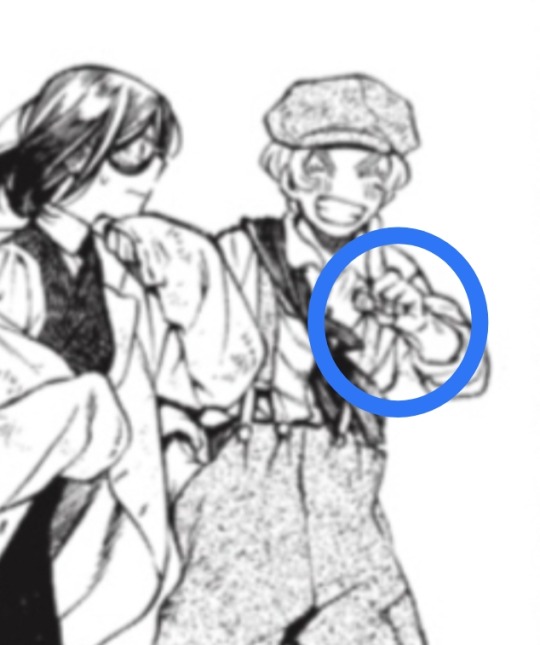
As a kid, he didn't have any scar so we know this is something he got as a Chasseur.
(image from 46.5 of Roland covered in bandages)
When he started training he was covered in bandages so we can't tell if he got his scars here or not. But anyways, this is the nearest event to him and Olivier meeting because it's when they started the training XD
(image of Roland and Misha in memoire 47. Roland has right arm broken and is fully covered in bandages again)
When he met Misha after a nearly death experience, Roland was totally covered again + and eye patch (here is when I think he got the injuries that become his scars).
This event can be near to when they started training, but it can't be near the time Astolfo met Roland because in that moment Roland and Olivier were full recovered.
+ I don't think this happened after rescuing Astolfo because basically, taking care of Astolfo became 24/7 Roland's job.

And finally here we are able to see his scars. It's near to when they rescued Astolfo so that's other point to think he got all of that before Roland and Astolfo met.
(imagine is yellow) 3) When Olivier planned to leave the Chasseurs a.k.a. When Roland met Misha:
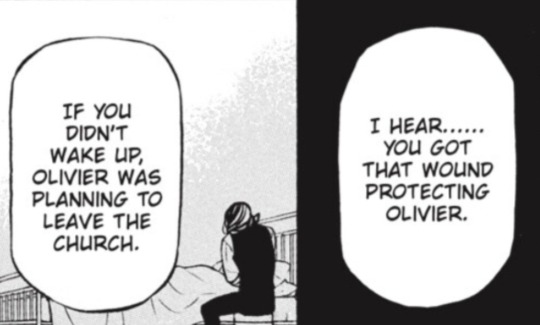
Back to the timeline, as I explained with Roland's scars, this has to be before rescuing Astolfo.
And again, this event can be near to when they started training, but it can't be near to when they rescued Astolfo because both Roland and Olivier had their arms broken. And depending what it's broken you need around 2 months or more to use it normally again (maybe the Chasseurs have drugs to make it shorter, but I will ignore that).
4) Olivier and Astolfo met:


We can't really know if this was the first time they see each other or even if this 2 panels are from the same day, but there are 2 important things to note:
Olivier wasn't a Paladin yet.
Astolfo already know the vampire.
5) The doomed day:

Between the previous event to this one there shouldn't be much time and, since Astolfo wears the exact same suit, I could even tell it was that same night. But kids can use the same clothes in different days so it can be more time between these events.
Side note 2: UwU I killed.
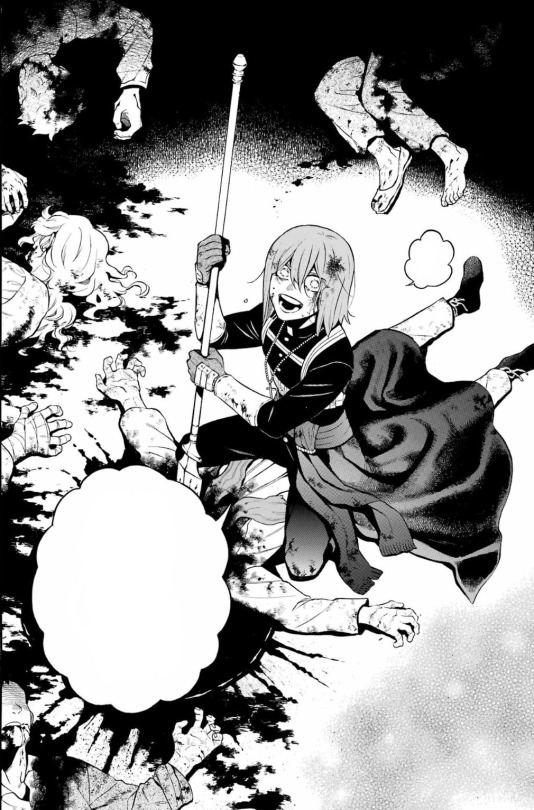
Since Astolfo wasn't a Paladin here and he is really similar to the present day, I think this happened around a year ago because Astolfo became Paladin at 15 and he is still 15 y.o.
6) Present day:
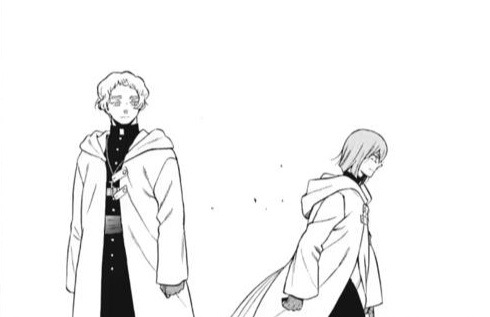
It's still 1888 because Astolfo's birthday is 6th January (basically, first day of 1889) and since he still 15, they are probably at the end of 1888.
Here both Roland and Astolfo are Paladins, but Astolfo ascended time before Roland.
.
.
.
And that's all, thanks for reading my mucho texto.
#vanitas no carte#vnc#the case study of vanitas#timeline#spoilers#roland fortis#astolfo granatum#olivier obsidian#sorry for the lack of images#they said you can update 20 images now instead of 10#they lied#>:[
155 notes
·
View notes
Text
The napoleonic marshal‘s children
After seeing @josefavomjaaga’s and @northernmariette’s marshal calendar, I wanted to do a similar thing for all the marshal’s children! So I did! I hope you like it. c:
I listed them in more or less chronological order but categorised them in years (especially because we don‘t know all their birthdays).
At the end of this post you are going to find remarks about some of the marshals because not every child is listed! ^^“
To the question about the sources: I mostly googled it and searched their dates in Wikipedia, ahaha. Nevertheless, I also found this website. However, I would be careful with it. We are talking about history and different sources can have different dates.
I am always open for corrections. Just correct me in the comments if you find or know a trustful source which would show that one or some of the dates are incorrect.
At the end of the day it is harmless fun and research. :)
Pre 1790
François Étienne Kellermann (4 August 1770- 2 June 1835)
Marguerite Cécile Kellermann (15 March 1773 - 12 August 1850)
Ernestine Grouchy (1787–1866)
Mélanie Marie Josèphe de Pérignon (1788 - 1858)
Alphonse Grouchy (1789–1864)
Jean-Baptiste Sophie Pierre de Pérignon (1789- 14 January 1807)
Marie Françoise Germaine de Pérignon (1789 - 15 May 1844)
Angélique Catherine Jourdan (1789 or 1791 - 7 March 1879)
1790 - 1791
Marie-Louise Oudinot (1790–1832)
Marie-Anne Masséna (8 July 1790 - 1794)
Charles Oudinot (1791 - 1863)
Aimee-Clementine Grouchy (1791–1826)
Anne-Francoise Moncey (1791–1842)
1792 - 1793
Bon-Louis Moncey (1792–1817)
Victorine Perrin (1792–1822)
Anne-Charlotte Macdonald (1792–1870)
François Henri de Pérignon (23 February 1793 - 19 October 1841)
Jacques Prosper Masséna (25 June 1793 - 13 May 1821)
1794 - 1795
Victoire Thècle Masséna (28 September 1794 - 18 March 1857)
Adele-Elisabeth Macdonald (1794–1822)
Marguerite-Félécité Desprez (1795-1854); adopted by Sérurier
Nicolette Oudinot (1795–1865)
Charles Perrin (1795–15 March 1827)
1796 - 1997
Emilie Oudinot (1796–1805)
Victor Grouchy (1796–1864)
Napoleon-Victor Perrin (24 October 1796 - 2 December 1853)
Jeanne Madeleine Delphine Jourdan (1797-1839)
1799
François Victor Masséna (2 April 1799 - 16 April 1863)
Joseph François Oscar Bernadotte (4 July 1799 – 8 July 1859)
Auguste Oudinot (1799–1835)
Caroline de Pérignon (1799-1819)
Eugene Perrin (1799–1852)
1800
Nina Jourdan (1800-1833)
Caroline Mortier de Trevise (1800–1842)
1801
Achille Charles Louis Napoléon Murat (21 January 1801 - 15 April 1847)
Louis Napoléon Lannes (30 July 1801 – 19 July 1874)
Elise Oudinot (1801–1882)
1802
Marie Letizia Joséphine Annonciade Murat (26 April 1802 - 12 March 1859)
Alfred-Jean Lannes (11 July 1802 – 20 June 1861)
Napoléon Bessière (2 August 1802 - 21 July 1856)
Paul Davout (1802–1803)
Napoléon Soult (1802–1857)
1803
Marie-Agnès Irma de Pérignon (5 April 1803 - 16 December 1849)
Joseph Napoléon Ney (8 May 1803 – 25 July 1857)
Lucien Charles Joseph Napoléon Murat (16 May 1803 - 10 April 1878)
Jean-Ernest Lannes (20 July 1803 – 24 November 1882)
Alexandrine-Aimee Macdonald (1803–1869)
Sophie Malvina Joséphine Mortier de Trévise ( 1803 - ???)
1804
Napoléon Mortier de Trévise (6 August 1804 - 29 December 1869)
Michel Louis Félix Ney (24 August 1804 – 14 July 1854)
Gustave-Olivier Lannes (4 December 1804 – 25 August 1875)
Joséphine Davout (1804–1805)
Hortense Soult (1804–1862)
Octavie de Pérignon (1804-1847)
1805
Louise Julie Caroline Murat (21 March 1805 - 1 December 1889)
Antoinette Joséphine Davout (1805 – 19 August 1821)
Stephanie-Josephine Perrin (1805–1832)
1806
Josephine-Louise Lannes (4 March 1806 – 8 November 1889)
Eugène Michel Ney (12 July 1806 – 25 October 1845)
Edouard Moriter de Trévise (1806–1815)
Léopold de Pérignon (1806-1862)
1807
Adèle Napoleone Davout (June 1807 – 21 January 1885)
Jeanne-Francoise Moncey (1807–1853)
1808: Stephanie Oudinot (1808-1893)
1809: Napoleon Davout (1809–1810)
1810: Napoleon Alexander Berthier (11 September 1810 – 10 February 1887)
1811
Napoleon Louis Davout (6 January 1811 - 13 June 1853)
Louise-Honorine Suchet (1811 – 1885)
Louise Mortier de Trévise (1811–1831)
1812
Edgar Napoléon Henry Ney (12 April 1812 – 4 October 1882)
Caroline-Joséphine Berthier (22 August 1812 – 1905)
Jules Davout (December 1812 - 1813)
1813: Louis-Napoleon Suchet (23 May 1813- 22 July 1867/77)
1814: Eve-Stéphanie Mortier de Trévise (1814–1831)
1815
Marie Anne Berthier (February 1815 - 23 July 1878)
Adelaide Louise Davout (8 July 1815 – 6 October 1892)
Laurent François or Laurent-Camille Saint-Cyr (I found two almost similar names with the same date so) (30 December 1815 – 30 January 1904)
1816: Louise Marie Oudinot (1816 - 1909)
1817
Caroline Oudinot (1817–1896)
Caroline Soult (1817–1817)
1819: Charles-Joseph Oudinot (1819–1858)
1820: Anne-Marie Suchet (1820 - 27 May 1835)
1822: Henri Oudinot ( 3 February 1822 – 29 July 1891)
1824: Louis Marie Macdonald (11 November 1824 - 6 April 1881.)
1830: Noemie Grouchy (1830–1843)
——————
Children without clear birthdays:
Camille Jourdan (died in 1842)
Sophie Jourdan (died in 1820)
Additional remarks:
- Marshal Berthier died 8.5 months before his last daughter‘s birth.
- Marshal Oudinot had 11 children and the age difference between his first and last child is around 32 years.
- The age difference between marshal Grouchy‘s first and last child is around 43 years.
- Marshal Lefebvre had fourteen children (12 sons, 2 daughters) but I couldn‘t find anything kind of reliable about them so they are not listed above. I am aware that two sons of him were listed in the link above. Nevertheless, I was uncertain to name them in my list because I thought that his last living son died in the Russian campaign while the website writes about the possibility of another son dying in 1817.
- Marshal Augerau had no children.
- Marshal Brune had apparently adopted two daughters whose names are unknown.
- Marshal Pérignon: I couldn‘t find anything about his daughters, Justine, Elisabeth and Adèle, except that they died in infancy.
- Marshal Sérurier had no biological children but adopted Marguerite-Félécité Desprez in 1814.
- Marshal Marmont had no children.
- I found out that marshal Saint-Cyr married his first cousin, lol.
- I didn‘t find anything about marshal Poniatowski having children. Apparently, he wasn‘t married either (thank you, @northernmariette for the correction of this fact! c:)
#Marshal‘s children calendar#literally every napoleonic marshal ahaha#napoleonic era#Napoleonic children#I am not putting all the children‘s names into the tags#Thank you no thank you! :)#YES I posted it without double checking every child so don‘t be surprised when I have to correct some stuff 😭#napoleon's marshals#napoleonic
66 notes
·
View notes
Note
Do you still do SOL headcanons? I was just wondering if you have or what do any WingDing ones if you did. If not, that's completely fine!! Sorry for bothering you.
Aaah, I'm so sorry for not responding right away!! No, you are not bothering me, and I appreciate your taking your time! I'm so sorry :(
*Ahem*
I do, actually! I've had an occasional thinking about how Wingdings was 18 around the time of his mother's death and probably had to give up the idea of wanting to go to a university at the time. He had to depend on any job he could grab on to, and of course, wound up in Dreemurr's allegiance after an "interesting occurrence."
I also believe that Wingdings was born on January 25, 1889. His mother, Mar, was roughly 19 at the time and had been living with a man (Arhmas) who she was not married to (still heavily implied to be his father) not really out of love (on his part at least) but for a place to stay in return for her "service"
She homeschooled Wingdings with the knowledge she knew from her father (who unfortunately went missing, I'll talk about him later) and with books she could spare to buy. Of course, Arhmas didn't really bother with Wingdings and had a mutual hate for each other.
Some point, 10 years later, Sans was born on April 30, 1899, and was (surprisingly) favored by Arhmas, who claimed his strength and teleportation skills had potential. Wingdings was very protective of his brother and felt uncomfortable with Arhmas' ideas of bringing Sans into any businesses later on in the future once he was grown. (Funny enough, like father like son, Arhmas had a sailor's mouth)
The time living with Arhmas went to a close when Papyrus was born, 5 years afterward, on August 19, 1905, when Arhmas had arrived home extremely drunk and pissed off from an incident at work, and took it out on Mar, blaming and beating her.
Wingdings, 15 at the time, retaliated in his mother's defense. Long story short, Mar and her sons left Arhmas and never came back, and Wingdings had two nasty scars that gave him the cryptic look he holds today.
The few months post-Arhmas was rough, Mar had to do many unpleasant jobs to support her family, specifically her newborn, and Wingdings helped along work at many odd jobs.
Of course, when opportunities came, Mar would bring her children to the Marsh fields to have a family time and talk about many things. It was a hard but good time in their lives. But, afterward, it got better when Sans and Papyrus had found the shed, (at least what they called it), it was an abandoned hunter's cabin that was left behind.
This became their permanent home. Until, of course, after Mar's unfortunate death.
(I'll put a pause on this, but I hope this first part of The Gaster Family Lore was entertaining enough. Thank you for your time.)
#sooner or later you're gonna be mine#solygbm#wingdings gaster#Sans Gaster#Papyrus gaster#sans's mother#ask blog
8 notes
·
View notes
Photo

Thomas Hart Benton - Self portrait
Thomas Hart Benton (April 15, 1889 – January 19, 1975) was an American painter, muralist, and printmaker. Along with Grant Wood and John Steuart Curry, he was at the forefront of the Regionalist art movement.
76 notes
·
View notes
Text

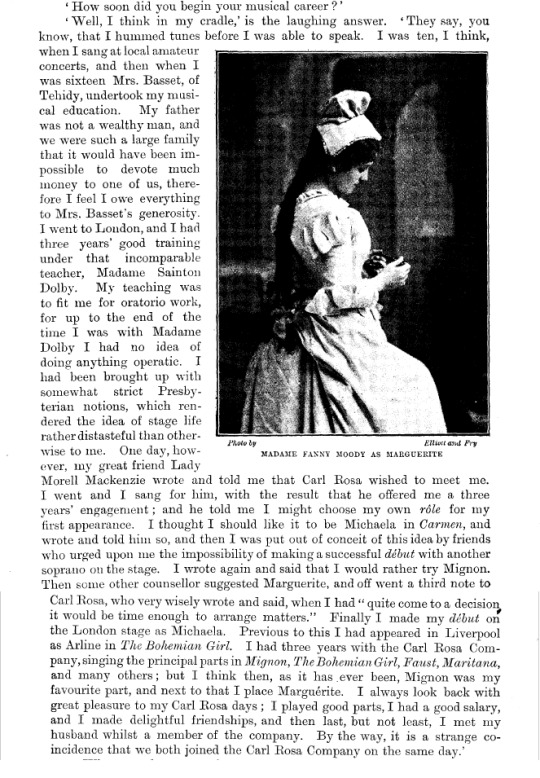



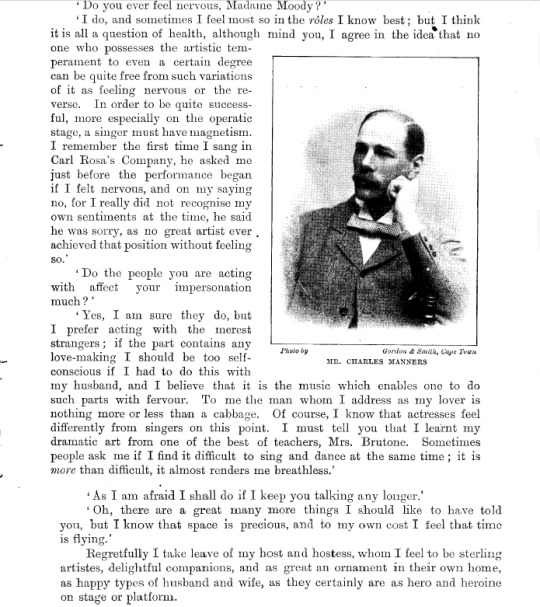
Fanny Moody – The Cornish Nightingale
Dame Fanny Moody (1864-1945) of Redruth was known as ‘The Cornish Nightingale’. Her father could, it was said, play any instrument he had ever seen. Her mother was a pianist, and their large family were exceptionally musical, in particular the daughters Fanny (Francis), Lily (1867-1950), Mabel (1874-1952) and Hilda (1876-1961). Newspaper reports show that all the sisters performed locally as young women. Fanny went on to become one of the great singing stars of her age. Hilda joined the D’Oyly Carte Opera Company in 1896, and later toured with her elder sister’s opera company. Lily, mezzo soprano, sang with J. W. Turner’s English Opera Company (1887-1902).
Fanny, allegedly seen dancing on a shop counter when young, became a pupil of Robert Heath of Redruth. Her first reported performance was in Ponsanooth on 26 March 1879 at the age of 14. Later that year Fanny’s mother died and her father was left with seven children. Nevertheless, in the winter of 1879/80, Fanny performed over a dozen concerts, mostly in Redruth, but also in Penzance and Falmouth. This intensive pattern was repeated in the next two winters, during which she built a large local following.
Her talent was recognized by Lady Mary Basset of Tehidy, who in late 1881 paid for her to train in London at the Vocal Academy of the renowned Mme. C. H. Sainton-Dolby. Fanny made her London début at the Steinway Hall, Seymour Street in June 1883. In April 1884, with other students, she gave a concert in Newcastle. All was loyally reported in Cornish newspapers.
In Newcastle she was heard by Charles Hallé, who offered her a series of return bookings. Through these she met Carl Rosa, manager of a prestigious opera company, and when asked by him to sing a ‘top C’ she gave him a ‘top D’. She made her début with the Carl Rosa Company in Liverpool on 15 January 1887, in The Bohemian Girl. Later that year Fanny’s father James died, but having seen three of his daughters on their way to operatic success. In 1889 Fanny, her fiancé, the noted bass, Charles Manners, and her sister Lily made a triumphant return to The Druid’s Hall, Redruth. The packed event was a both a celebration of Fanny’s success and of her Cornish roots.
In 1892 Charles Manners and Fanny were married. Fanny went from success to success as an operatic soprano. In 1892 she and her sister Lily sang in the first English performance of Tchaikovsky’s Yevgeny Onegin. Fanny sang many roles, including Wagner, but she was most suited to those like Cio-Cio-san, the tragic heroine of Puccini’s Madam Butterfly. Later, she and her husband formed the Moody-Manners Opera Company which operated from 1898 to 1916.
Most of Fanny’s performing life was spent touring Britain but she also travelled abroad, notably to North America and South Africa. There in 1897, after a concert, expatriot Cornish admirers followed her back to her hotel. A newspaper reported ‘There was an assemblage of enthusiastic but strangely silent and peaceful Cornishmen; this congregation of robust Romeos waited for their Juliet to appear upon the balcony…To the silent she sang Cornish songs. And as she sang, these big men of Cornwall wept.’ She was presented with a tiara with the Cornish coat of arms picked out in diamonds, which was donated for auction in the Second World War with the proceeds going to the Red Cross.
Although she travelled the world Fanny was still seen as a ‘Cornish maid’ and regularly reported in a positive, almost avuncular way by Cornish papers. Her reputation, repertoire and audience were international, but her identity was Cornish, and her success, and that of Lily and Hilda, grew from the Cornish musical environment.
Laura Alex Smith published an interview with Fanny Moody in the Cornish Magazine in 1898 which provides an insight into the singer and her world.
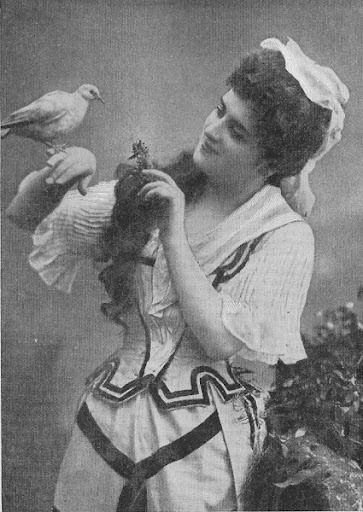
#classical music#opera#music history#bel canto#composer#classical composer#aria#classical studies#maestro#chest voice#Fanny Moody#The Cornish Nightingale#The Nightingale#Carl Rosa Opera Company#Moody-Manners Opera Company#Drury Lane#classical musician#classical musicians#classical history#opera history#historian of music#history of music#musician#musicians#diva#prima donna
4 notes
·
View notes
Text

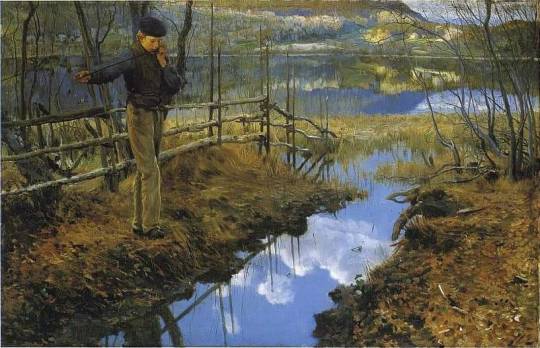

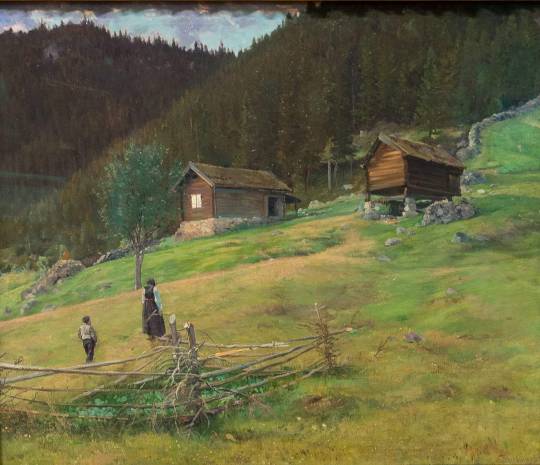

"Christian Skredsvig (12 March 1854 – 19 January 1924) was a Norwegian painter and writer. He employed an artistic style reflecting naturalism. He is especially well known for his picturesque and lyrical depictions of the landscape. He was born and grew up on the Skredsvig farm in the parish of Modum in Buskerud, Norway.
When he was 15 years old he became a pupil at the drawing and paint school of Johan Fredrik Eckersberg in Christiania. After Eckersberg's death in 1870 he studied with Julius Middelthun at Norwegian National Academy of Craft and Art Industry (Den kgl. Tegneskole) in Kristiania (now Oslo). He followed with four years of apprenticeship (1870–1874) in Copenhagen under the supervision of landscape painter Vilhelm Kyhn at the Royal Danish Academy of Fine Arts.
After several years in Paris he moved back to Norway in 1886 and settled at the Fleskum farm in Bærum. His new home became a gathering place for painters, poets and musicians. Eilif Peterssen, Kitty Kielland, Harriet Backer and Erik Werenskiold all made trips to the farm. Skredsvig's famous neo-romantic painting Seljefløiten (1889) was painted by the Lake Dælivannet in Bærum. He also conducted study trips, to Corsica in 1888 and to southern France in 1891.
In 1894, he moved to Eggedal in Sigdal municipality where he built his home Hagan. In the natural landscape of Eggedal, Skredsvig found inspiration and motives to paint".
> Pomah Konomieub > Painters from the North
5 notes
·
View notes
Photo



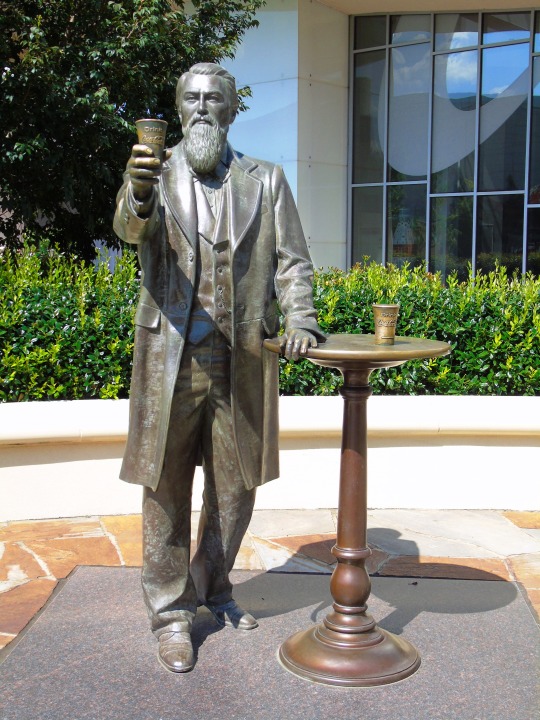


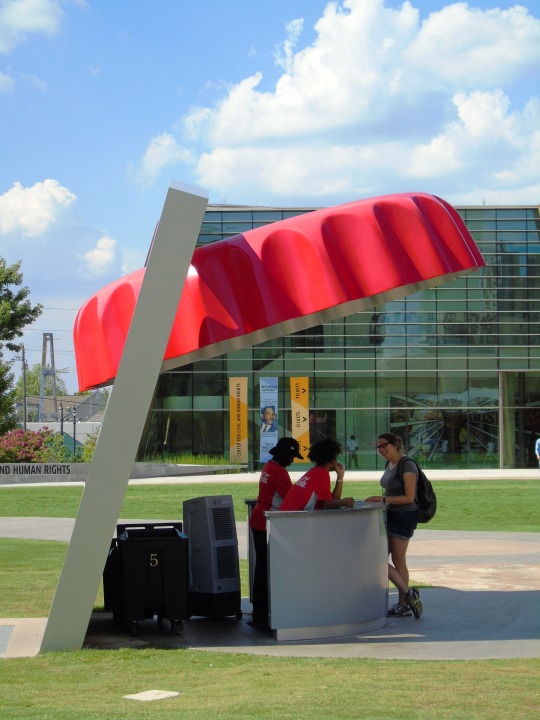



The Coca-Cola Company, then known as the Pemberton Medicine Company, was incorporated in Atlanta on January 15, 1889.
#Coca-Cola Company#Pemberton Medicine Company#incorporated#Atlanta#15 January 1889#anniversary#US history#soft drink#Georgia#vacation#Centennial Olympic Park#World of Coca-Cola#original photography#USA#summer 2016#tourist attraction#landmark#architecture#cityscape#Gott's Roadside#St. Helena#California
3 notes
·
View notes
Photo



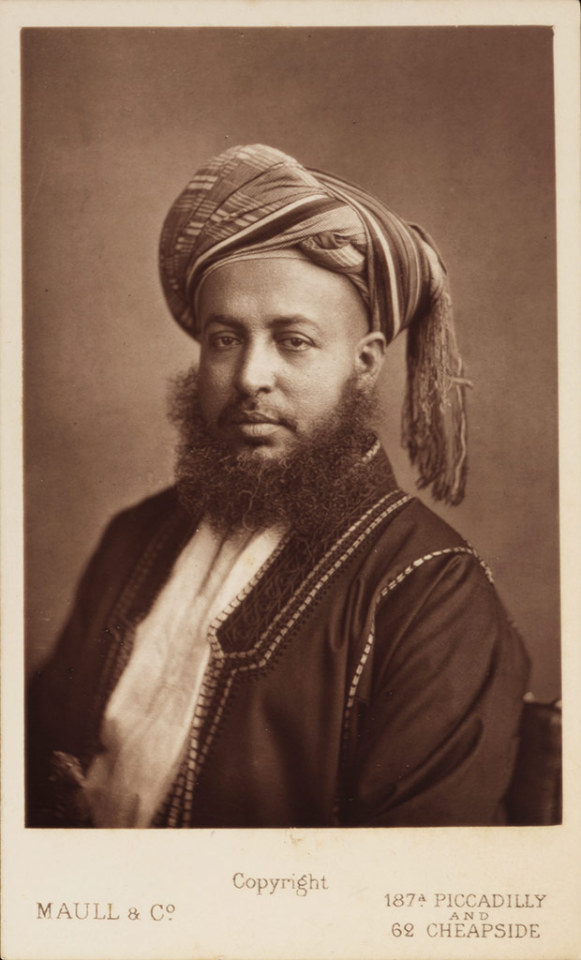

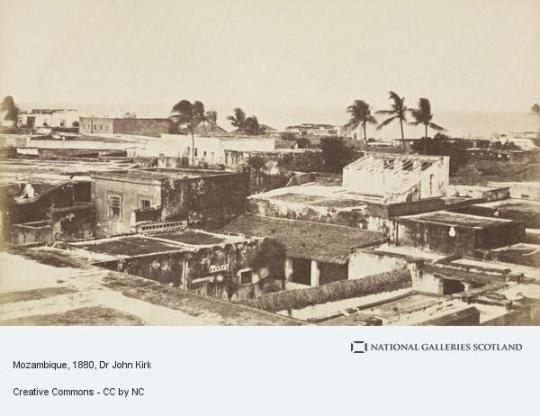
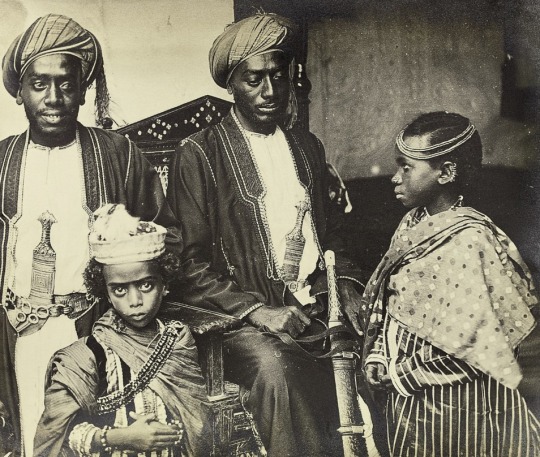
John Kirk was born in Barry, Angus, near Arbroath December 19th 1832.
Another Scot that few of us will know, but his story deserves a lot more attention than it gets, he was instrumental in ending slavery in Zanzibar through his influence with the then Sultan.
Born the second of the four children of the Rev. John Kirk who was himself a keen botanist. He became interested in botany at a very early age since it was his father’s principal hobby. His father tutored him at first then he attended the local high school in Arbroath and he matriculated at the age of 15 and entered Edinburgh University in 1847 at that age first the Arts faculty then the Medical School. By the time he was 22 he graduated from the medical faculty, MD, LRCS. He was also a pupil of the famous botanist Prof. I. H. Balfour during this period
He first took a post as resident physician at the Royal Edinburgh Infirmary, one of his colleagues being Joseph Lister. The Crimean war had just started and like many other young doctors Kirk sailed for the area in 1855; there he stayed until 1856 being stationed mainly at Erenkevi in the Dardanelles and at Scutari. After the Crimean episode he collected plants on Mt. Ida and Mt. Olympus before returning to London in 1856. He was soon off again, however, this time to Syria, Palestine, Egypt and Italy arriving back in London once again in 1857.
From 1858–1863 he was physician, economic botanist and naturalist (and later chief officer) to Livingstone’s Zambesi Expedition. When Livingstone first approached him about this post Kirk is reported to have been so enthusiastic that he replied ‘be ready tomorrow’. Actually being a good Scot he was not quite that impetuous and wanted to have details of ‘the necessary expenses’. Livingstone’s classic reply of 4th January 1858 was ;
‘I am not quite clear as to what you mean with regard to necessary expenses. Suppose you shoot a buffalo there will be no expense incurred in cooking and eating it. There are no inns or hotels in the country. The lodging will all be free – expeditions of this kind cannot be successful unless all the members are willing to rough it and it will be well if we all thoroughly understand this before we start. The salary is £350 per annum.‘
Livingstone and Kirk got on very well and in a letter, Livingstone recorded his personal views as follows
‘The Doctor has been I can assure you a most assiduous and painstaking collector – nothing ever deterred him from doing his duty and he did it like a man. If you can confer any favour on him you will never find a more deserving recipient – this I can say after five years of constant intercourse’.
The reason Kirk remained friends with Livingstone when so many others failed is partly due to his outstanding qualities of forbearance and understanding and partly that Kirk was the only other member of the expedition with the physical toughness and the strength of will to match Livingstone’s own. His last association with Livingstone was to act as a pall-bearer on 18 April 1874 at Livingstone’s funeral in Westminster Abbey – the others included Stanley and Jacob Wainwright, one of the Africans who had carried Livingstone’s body to the coast after his death; a long and fantastic journey of 11 months.
From 1866 to 1873 Kirk was Vice Consul for Zanzibar and later Assistant Political Agent. In 1873 he was appointed Consul General at Zanzibar and under his influence the Sultan abandoned slavery in his dominions. In 1880 he was Political Agent at Zanzibar and was created KCMG in 1881. He retired in 1887 on account of ill-health. From 1889–1890 he was a diplomat for Britain at the Brussels Anti-Slavery Conference where his long association with the problem was of enormous value. He was created KCB in 1890. He was one of those many giants produced by the Victorian era and his great strength of character shows in the various portraits which exist.
He was very interested in the practical uses of plants and during the Zambesi expedition he made experiments with Strophanthus which was used as an arrow poison by the natives in the area. He discovered its effect on the heart and sent material back to Edinburgh for more detailed investigation. As a result strophanthinum was added to the pharmacopeia and a minor industry started in Central Africa. It is still used as a heart stimulant. He was quick to see the possibilities of an area and published a report on the natural products and capabilities of various areas he visited with Livingstone. He recommended the Shire Highlands for European settlement, the Manganja Hills for coffee planting and the Batoka Highlands for cattle ranching. Kirk fostered the Zanzibar copal industry, the resin from a leguminous plant important in the manufacture of varnish. He also developed the important india-rubber trade, the rubber being obtained not from Hevea (then not grown in the Old World) but from wild climbers of the genus Landolphia.
John Kirk was also one of the earliest amateur photographers and certainly the first to take photographs of vegetation in the Zambesi area if not in tropical Africa. Wax negatives of the 1859 photographs are still extant and quite excellent prints taken from them. Many of these have been reproduced in Coupland’s fascinating book ‘Kirk on the Zambesi’ and by Foster in his "The Zambesi Journal and letters of Dr. John Kirk" and "The Zambesi Doctors".
Pics are of John Kirk, second is with his wife and daughter, the fourth pic is Sultan of Zanzibar, Sayyid Sir Barghash bin Sa'id (ruled 1870-1888). Other pics were taken by Kirk during his years in Africa.
More about Dr Kirk and his time in Africa here https://www.abctales.com/story/angusfolklore/sir-john-kirk-and-end-slavery-zanzibar
10 notes
·
View notes
Text
SAINT OF THE DAY (November 19)
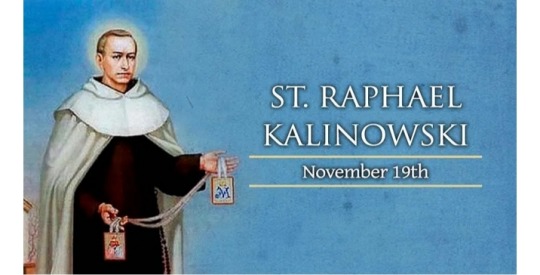
Saint Raphael Kalinowski was born on 1 September 1835 as Joseph, son of Andrew and Josepha Kalinowski in present day Lithuania.
Saint Raphael felt a call to the priesthood early in his life but decided to complete his education.
He studied zoology, chemistry, agriculture, and apiculture at the Institute of Agronomy in Hory Horki, Russia, and at the Academy of Military Engineering in Saint Petersburg, Russia.
Saint Raphael became a Lieutenant in the Russian Military Engineering Corps in 1857.
During his post, he was responsible for the planning and supervised construction of the railway between Kursk and Odessa. He was promoted to captain in 1862 and stationed in Brest-Litovsk.
In Bret-Litovsk, he started, taught and covered all the costs of a Sunday school, accepting anyone interested. In 1863, he supported the Polish insurrection.
He resigned from the Russian army and became the rebellion's minister of war for the Vilna region. He only took the commission with the understanding that he would never hand out a death sentence nor execute a prisoner.
He was soon arrested by Russian authorities. In June 1864, he was condemned to death for his part in the revolt.
Fearing they would be creating a political martyr, they commuted his sentence to ten years of forced labour in the Siberian salt mines.
Part of his sentence was spent in Irkutsk, where his relics have been moved to sanctify the new cathedral.
Upon his release in 1873, he was exiled from his home region in Lithuania. He moved to Paris and worked there as a tutor for three years.
In 1877, he finally answered the long-heard call to the religious life and joined the Carmelite Order at Graz, Austria, taking the name Raphael.
He studied theology in Hungary and then joined the Carmelite house in Czama, Poland. He was ordained on 15 January 1882.
Saint Raphael worked to restore the Discalced Carmelites. In 1889, he founded a convent at Wadowice, Poland, and worked alongside Blessed Alphonsus Mary Marurek.
He was a noted spiritual director for both Catholics and Orthodox. He was considered an enthusiastic parish priest and spent countless hours with his parishioners in the confessional.
Raphael died of tuberculosis on 15 November 1907.
Pope John Paul II beatified Raphael on 22 June 1983 in Kraków, Poland, and canonized on 17 November 1991 in St. Peter's Basilica.
He was the first man to be so recognized in the Order of Discalced Carmelites since John of the Cross.

6 notes
·
View notes
Text
fox and coyote, ghost of philza AU part 3 1/2
so, this is an AU about philza. in this AU philza wasn't always immortal he was in fact a mortal born in 1861 Londen 24 years after queen Vicktoria, his name was Philipp logos Riceshire and his family had 3 sons and 4 daughters and how he became philza logos Minecraft...
So, this AU is called fox and coyote or red blood feathers with wax skin.
The reason for this is because Philza got tuberculosis around 17 about to 18 years old and he was born in the 1861 and this was in 1880s when he got sick. So, he survived it and looked at a walking skeleton with some meat on his bones and so many made rumors that he was immortal at born so this made his ego soar. The society he grew up in was forcing him to grow up fast so when he about 15 or 16 they all treated like a mature adult, so he was holding back the impulse of a normal teen or child.
the only solace he got was through his oldest brother’s stories and his sister’s paintings, but only brother his was close too died to frost bite and after a year of getting to a better weight he swore that he would get wings like the people in place where his family was before moving to Europe. He did got to suntail to change his fate and mess up and burned about 50 unfinish tapestries with pyro’s fire which cause he to fight for the wings and have they added to him in the most painful way possible with wax and feathers.
the bones of his wings were a harness and metal ammeter and turned from leather harness and metal to bones and bone marrow and after getting he got the curse or gift of immortally and then after he let out all the impulses and urges, he hid for long were set free which cause he to snapped and turn a little crazy and bloody since he was hiding and mellowed out in the 1930s.
from 1889 January to 1929 October 31 at midnight he was so bloody and murderous, the gods made sure he wasn’t too much. Then got the curse of empath after his first close friend betrayed him in the start of war in England so that fun.
#ghostza#ghost au#dream smp#philza angst#philza headcanons#angst#dream smp mumza#violin#techno and philza#technoblade#my au
2 notes
·
View notes
Text
Cathay Williams, first African-American woman to serve in the U.S. Army
November 15, 1866: Cathay Williams became the first African American woman to serve in the U.S. Army, and the only woman to serve in the U.S. Army as a Buffalo Soldier.
Williams was born to an enslaved mother and a free father in Independence, Missouri in 1844. At 17 years old, Williams first served as an Army cook and a washerwoman. During this time, African Americans who had been captured were forced to serve in military support as contraband for Union forces. Williams enlisted in the U.S. Regular Army under the false name “William Cathay” on November 15, 1866. She was assigned to the 38th U.S. infantry Regiment, one of the all-black regiments recently established, that would become part of the renown Buffalo Soldiers. The Army did not require full medical exams at the time, so she was able to pass as a man.
When Williams began to feel the effects of smallpox and was hospitalized, it was discovered that she was actually a woman. Lewis was honorably discharged by her commanding officer, Captain Charles E. Clarke, on October 14, 1868. Following her discharge, Williams went to work as a cook at Fort Union, New Mexico, and later moved to Pueblo, Colorado. Around 1889 or 1890, Williams entered a hospital and applied for disability pension based on her medical service. Her request was denied. In 1893, a doctor’s examination revealed that Willaims suffered from neuralgia and diabetes. She had all her toes amputated and walked with a crutch. The doctor determined that she did not qualify for disability payments. While the exact date of her death is unknown, it is believed that Williams died shortly after she was denied.
Williams’ interview that was published in the St. Louis Daily Times on January 2, 1876:
"My Father a was a freeman, but my mother a slave, belonging to William Johnson, a wealthy farmer who lived at the time I was born near Independence, Jackson county, Missouri. While I was a small girl my master and family moved to Jefferson City. My master died there and when the war broke out and the United States soldiers came to Jefferson City they took me and other colored folks with them to Little Rock. Col. Benton of the 13th army corps was the officer that carried us off. I did not want to go. He wanted me to cook for the officers, but I had always been a house girl and did not know how to cook. I learned to cook after going to Little Rock and was with the army at The Battle of Pea Ridge. Afterwards the command moved over various portions of Arkansas and Louisiana. I saw the soldiers burn lots of cotton and was at Shreveport when the rebel gunboats were captured and burned on Red River. We afterwards went to New Orleans, then by way of the Gulf to Savannah Georgia, then to Macon and other places in the South. Finally I was sent to Washington City and at the time Gen. Sheridan made his raids in the Shenandoah valley I was cook and washwoman for his staff I was sent from Virginia to some place in Iowa and afterwards to Jefferson Barracks, where I remained some time. You will see by this paper that on the 15th day of November 1866 I enlisted in the United States army at St. Louis, in the Thirty-eighth United States Infantry Company A, Capt. Charles E. Clarke commanding.
Captain Charles E. Clarke in the Civil War 6th Infantry at the Battle of Baton Rouge.
"The regiment I joined wore the Zouave uniform and only two persons, a cousin and a particular friend, members of the regiment, knew that I was a woman. They never 'blowed' on me. They were partly the cause of my joining the army. Another reason was I wanted to make my own living and not be dependent on relations or friends. Soon after I joined the army, I was taken with the small-pox and was sick at a hospital across the river from St. Louis, but as soon as I got well I joined my company in New Mexico. I was as that paper says, I was never put in the guard house, no bayonet was ever put to my back. I carried my musket and did guard and other duties while in the army, but finally I got tired and wanted to get off. I played sick, complained of pains in my side, and rheumatism in my knees. The post surgeon found out I was a woman and I got my discharge. The men all wanted to get rid of me after they found out I was a woman. Some of them acted real bad to me. After leaving the army I went to Pueblo, Colorado, where I made money by cooking and washing. I got married while there, but my husband was no account. He stole my watch and chain, a hundred dollars in money and my team of horses and wagon. I had him arrested and put in jail, and then I came here. I like this town. I know all the good people here, and I expect to get rich yet. I have not got my land warrant. I thought I would wait till the railroad came and then take my land near the depot. Grant owns all this land around here, and it won't cost me anything. I shall never live in the states again. You see I've got a good sewing machine and I get washing to do and clothes to make. I want to get along and not be a burden to my friends or relatives."
Leticia Wright stars in the 2023 film Surrounded. Her character, Moses “Mo” Washington, was modeled after the Cathay Williams. I’m also seeing a bit of Stagecoach Mary in Wright’s character.
Source: Smithsonian's National Museum of African American History and Culture Facebook, National Park Service, YouTube
Visit www.attawellsummer.com/forthosebefore to learn more about Black history and read new blog posts first.
Need a freelance graphic designer or illustrator? Send me an email.
#Cathay Williams#women in the military#U.S. Army#Buffalo Soldier#1800s#Missouri#1860s#American history#Black history#William Cathay#Colorado history
0 notes
Text
LOTD: Crabtree Ledge
(from: https://www.lighthousefriends.com/light.asp?ID=1864)
Crabtree Ledge, Maine (Timeline)
1887 – Crabtree Ledge, in Frenchman's Bay, Maine.—This ledge, upon which there are from 8 to 12 feet of water at mean low tide, was surveyed, title to the site, with jurisdiction, was secured from the state of Maine, and drawings, specifications, and estimates for the lighthouse were prepared.
1888 – Crabtree Ledge, Frenchman's Bay, Maine.— On August 4,1886, Congress appropriated $25,000 for the erection of a light-house at this place. The Board designed an appropriate structure for this location and advertised for proposals for furnishing the metal-work and for its erection. The bids received showed that the amount appropriated was insufficient for the erection of the proper structure at this location, and the Board therefore obtained an appropriation of the additional $13,000 necessary for the erection of this light house. The work will now be undertaken at the earliest date practicable.
1889 – Crabtree Ledge, about 1 ½ miles south of Mount Desert Ferry, Maine.— Contracts were made for the metal work, for the cement, and for the erection of the light-house. Part of the metal work and of the cement were delivered at Mount Desert Ferry. The location of the foundation cylinder was fixed upon the ledge, and the building of a crib-pier around it was commenced.
1890 – Crabtree's Ledge, Frenchman's Bay, Maine.—A fifth-order light, January 15, 1890.
1890 – Crabtree's Ledge, between Bar Harbor and Mount Desert Ferry, Frenchman's Bay, Maine.—The light-house recently constructed consists of a cylindrical iron caisson, 25 feet in diameter and 32 feet in height, founded upon a rock 15 feet below mean sea-level. It is filled with concrete and surmounted by an iron tower, 37 feet high from base to focal plane, and was finished December 31, 1889. A fixed white light of the fifth order, varied by a white flash every two minutes, illuminates the whole horizon, and was first exhibited on January 15, 1890.
1891 – Crabtree Ledge, Frenchman Bay, Maine.—A bell struck by machinery, August 1, 1890.
1891 – Crabtree Ledge, between Bar Harbor and Mount Desert Ferry, Frenchman Bay, Maine.—A 1,200-pound bell, struck by machinery, with a bell house of sheet iron, was placed upon the pier. Various minor repairs were made.
1895 – Crabtree Ledge, Frenchman Bay, Maine.—A landing ladder was made and fitted. Various repairs were made.
1903 – Crabtree Ledge, on Crabtree Ledge, Frenchman Bay, Maine.— The color of the tower was changed from brown to white, and the revolving clock and fog-bell machinery repaired.
1913 – J. H. Peasley, keeper, rendered assistance to Arthur L. Bunker in danger of drowning.
1914 – Jerome H. Peasley, keeper, rendered assistance in getting schooner-yacht White Wings off rocks near station.
1916 – J.H. Peasley, keeper, towed disabled motor boat with 1 man on board to shore.
1916 – October 2. Assistant Keeper Chester Brinkworth, 31, and his brother Charles [Arthur Leon], 27 [20], were drowned Saturday near Crabtree Ledge Lighthouse at the entrance to Sullivan Harbor, according to information received here today at the Lighthouse Department. Capt. Sherman went with the lighthouse tender Hibiscus to search for the bodies.
Charles Brinkworth fell from a dory, and his brother sprang overboard to rescue him, both perishing. Jerome C. Peaslee, keeper of the light, was ill, and his assistant, Chester Brinkworth, had gone ashore to bring back his brother as helper. The two were lost on the return trip.
Chester Brinkworth’s body and the capsized dory were found by the Hibiscus, which is searching for the body of Chester’s brother. The latter has left his home at Hancock Point in the face of a heavy wind and high seas. Friends advised against his making the trip, but young Brinkworrh said that, with the keeper in a hospital, his brother would be lonely.
1917 – March 21. Captain Joseph Whitmore, assistant keeper of Crabtree ledge light, was drowned by the capsizing of a boat in which he was returning to his post from Ellsworth, Me.
1933 – Crabtree Ledge Lighthouse discontinued.
1934 – Sold to a group of yachtsmen for $105.
1950 – Crabtree Ledge Lighthouse collapsed during a winter storm.
Keepers:
Head: Amaziah R. Small (1889 – 1898), Charles F. Chester (1898 – 1911), Jerome H. Peasley (1911 – at least 1917), Clarendon G. Hurd (at least 1919 – 1920), Ora S. Jordan (1920 – at least 1921), Thomas H. Morgan (at least 1926 – 1933).
Assistant: Francis T. Hodgkins (1893), Charles F. Chester (1893 – 1898), Joseph M. Gray (1898 – 1900), Rollins E. Dobbin (1900 – 1902), Frederick W. Morong, Jr. (1902), Charles W. Thurston (1902 – 1909), Jerome H. Peasley (1909 – 1911), A. R. Leeman (1911), Frank C. Crowley (1911 – at least 1912), Maurice R. Beal (at least 1913), Chester D. Brinkworth (1914 – 1916), Joseph Whitmore ( – 1917), F.N. Foss (at least 1917), Thomas H. Morgan (at least 1919 – at least 1924), Vassar L. Quimby (1926 – 1933).

(historic photo found from above listed website - actual source unknown)
0 notes
Photo
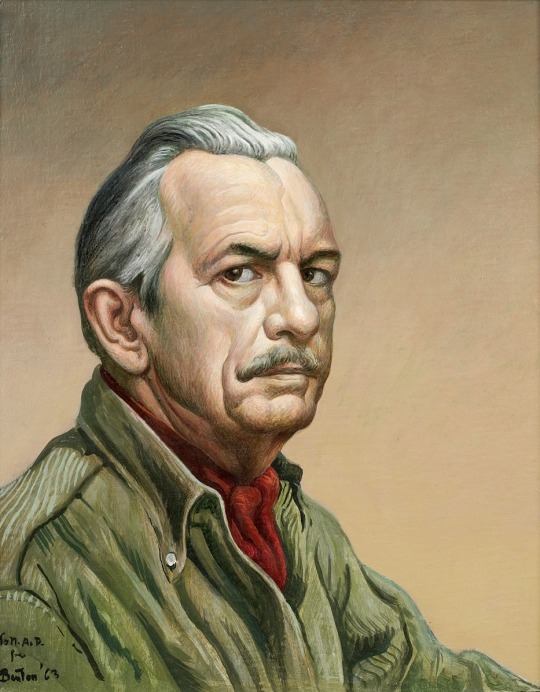
Thomas Hart Benton - Self-Portrait
Thomas Hart Benton (April 15, 1889 – January 19, 1975) was an American painter, muralist, and printmaker. Along with Grant Wood and John Steuart Curry, he was at the forefront of the Regionalist art movement.
20 notes
·
View notes
Text
On this day in Wikipedia: Saturday, 11th November
Welcome, Bienvenue, שלום, Bienvenida 🤗
What does @Wikipedia say about 11th November through the years 🏛️📜🗓️?

11th November 2022 🗓️ : Event - Russo-Ukrainian War
Russo-Ukrainian War: Ukrainian armed forces enter the city of Kherson following a successful two-month southern counteroffensive.
"The Russo-Ukrainian War is an ongoing international conflict between Russia and Ukraine, which began in February 2014. Following Ukraine's Revolution of Dignity, Russia annexed Crimea from Ukraine and supported pro-Russian separatists fighting the Ukrainian military in the Donbas war. The first..."

Image licensed under CC BY 4.0? by AFU StratCom
11th November 2017 🗓️ : Death - Chiquito de la Calzada
Chiquito de la Calzada, Spanish singer, actor and comedian (b. 1932)
"Gregorio Esteban Sánchez Fernández (28 May 1932, Málaga – 11 November 2017, Málaga), known as Chiquito de la Calzada, was a Spanish flamenco singer and actor, although he rose to fame as a stand-up comedian. Chiquito de la Calzada became very popular in Spanish TV shows (especially Genio y figura)..."

Image licensed under CC BY-SA 4.0? by Daniel Capilla
11th November 2013 🗓️ : Death - Atilla Karaosmanoğlu
Atilla Karaosmanoğlu, Turkish economist and politician, 33rd Deputy Prime Minister of Turkey (b. 1931)
"Atilla Karaosmanoğlu (20 September 1932 – 11 November 2013) was a Turkish economist and politician...."
11th November 1973 🗓️ : Death - Artturi Ilmari Virtanen
Artturi Ilmari Virtanen, Finnish chemist and academic, Nobel Prize laureate (b. 1895)
"Artturi Ilmari Virtanen (Finnish: [ˈɑrtːuri ˈʔilmɑri ˈʋirtɑnen] ; 15 January 1895 – 11 November 1973) was a Finnish chemist and recipient of the 1945 Nobel Prize in Chemistry "for his research and inventions in agricultural and nutrition chemistry, especially for his fodder preservation method".He..."
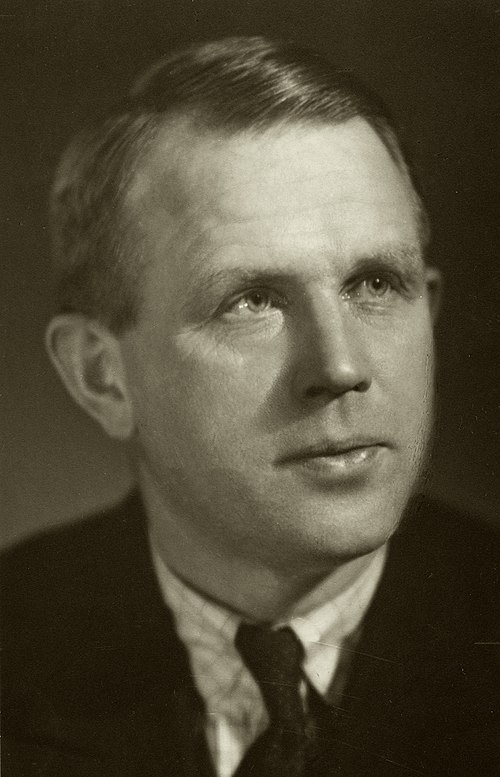
Image licensed under CC BY 4.0? by
AnonymousUnknown author
11th November 1923 🗓️ : Event - Adolf Hitler
Adolf Hitler is arrested in Munich for high treason for his role in the Beer Hall Putsch.
"Adolf Hitler (German: [ˈaːdɔlf ˈhɪtlɐ] ; 20 April 1889 – 30 April 1945) was an Austrian-born German politician who was the dictator of Germany from 1933 until his suicide in 1945. He rose to power as the leader of the Nazi Party, becoming the chancellor in 1933 and then taking the title of Führer..."

Image licensed under CC BY-SA 3.0 de? by Heinrich Hoffmann
11th November 1821 🗓️ : Birth - Fyodor Dostoevsky
Fyodor Dostoevsky, Russian novelist, short story writer, essayist, and philosopher (d. 1881)
"Fyodor Mikhailovich Dostoevsky (UK: , US: ; Russian: pre-1918: Ѳедоръ Михайловичъ Достоевскій; post-1918: Фёдор Михайлович Достоевский, tr. Fyódor Mikháylovich Dostoyévskiy, IPA: [ˈfʲɵdər mʲɪˈxajləvʲɪdʑ dəstɐˈjefskʲɪj] ; 11 November 1821 – 9 February 1881), sometimes transliterated as Dostoyevsky,..."

Image by Vasily Perov
11th November 🗓️ : Holiday - Christian feast day: Mercurius (Coptic)
"Mercurius (Greek: Ἅγιος Μερκούριος, Coptic: Ⲫⲓⲗⲟⲡⲁⲧⲏⲣ Ⲙⲉⲣⲕⲟⲩⲣⲓⲟⲥ; Syriac: ܡܳܪܩܘ̇ܪܝܘ̇ܣ; 224/225 – 250 AD) was a Roman soldier of Scythian descent who became a Christian saint and martyr. He was born in the city of Eskentos in Cappadocia, in Eastern Asia Minor (modern-day Turkey). According to..."
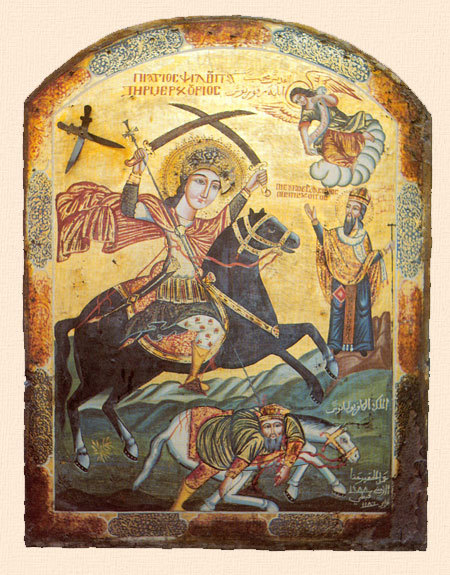
Image
0 notes